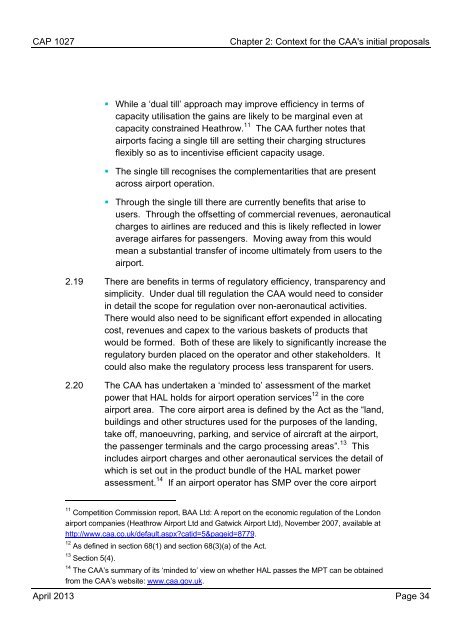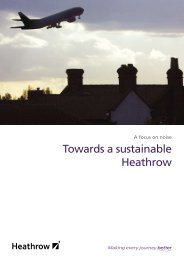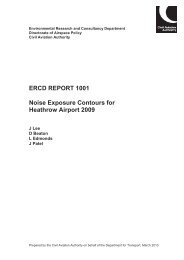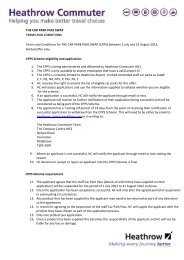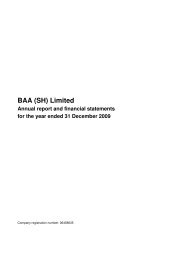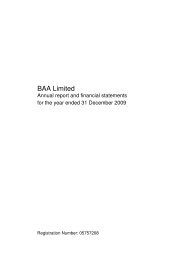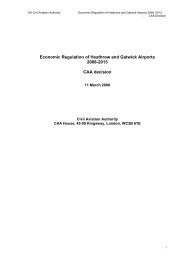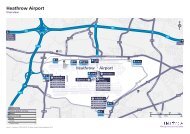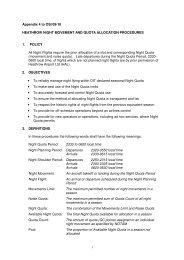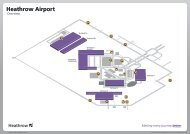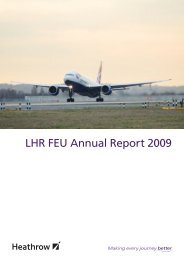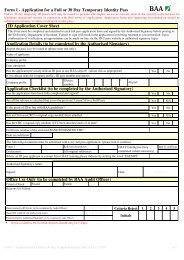the CAA said - Heathrow Airport
the CAA said - Heathrow Airport
the CAA said - Heathrow Airport
You also want an ePaper? Increase the reach of your titles
YUMPU automatically turns print PDFs into web optimized ePapers that Google loves.
CAP 1027<br />
Chapter 2: Context for <strong>the</strong> <strong>CAA</strong>'s initial proposals<br />
• While a ‘dual till’ approach may improve efficiency in terms of<br />
capacity utilisation <strong>the</strong> gains are likely to be marginal even at<br />
capacity constrained <strong>Heathrow</strong>. 11 The <strong>CAA</strong> fur<strong>the</strong>r notes that<br />
airports facing a single till are setting <strong>the</strong>ir charging structures<br />
flexibly so as to incentivise efficient capacity usage.<br />
• The single till recognises <strong>the</strong> complementarities that are present<br />
across airport operation.<br />
• Through <strong>the</strong> single till <strong>the</strong>re are currently benefits that arise to<br />
users. Through <strong>the</strong> offsetting of commercial revenues, aeronautical<br />
charges to airlines are reduced and this is likely reflected in lower<br />
average airfares for passengers. Moving away from this would<br />
mean a substantial transfer of income ultimately from users to <strong>the</strong><br />
airport.<br />
2.19 There are benefits in terms of regulatory efficiency, transparency and<br />
simplicity. Under dual till regulation <strong>the</strong> <strong>CAA</strong> would need to consider<br />
in detail <strong>the</strong> scope for regulation over non-aeronautical activities.<br />
There would also need to be significant effort expended in allocating<br />
cost, revenues and capex to <strong>the</strong> various baskets of products that<br />
would be formed. Both of <strong>the</strong>se are likely to significantly increase <strong>the</strong><br />
regulatory burden placed on <strong>the</strong> operator and o<strong>the</strong>r stakeholders. It<br />
could also make <strong>the</strong> regulatory process less transparent for users.<br />
2.20 The <strong>CAA</strong> has undertaken a ‘minded to’ assessment of <strong>the</strong> market<br />
power that HAL holds for airport operation services 12 in <strong>the</strong> core<br />
airport area. The core airport area is defined by <strong>the</strong> Act as <strong>the</strong> “land,<br />
buildings and o<strong>the</strong>r structures used for <strong>the</strong> purposes of <strong>the</strong> landing,<br />
take off, manoeuvring, parking, and service of aircraft at <strong>the</strong> airport,<br />
<strong>the</strong> passenger terminals and <strong>the</strong> cargo processing areas”. 13 This<br />
includes airport charges and o<strong>the</strong>r aeronautical services <strong>the</strong> detail of<br />
which is set out in <strong>the</strong> product bundle of <strong>the</strong> HAL market power<br />
assessment. 14 If an airport operator has SMP over <strong>the</strong> core airport<br />
11<br />
Competition Commission report, BAA Ltd: A report on <strong>the</strong> economic regulation of <strong>the</strong> London<br />
airport companies (<strong>Heathrow</strong> <strong>Airport</strong> Ltd and Gatwick <strong>Airport</strong> Ltd), November 2007, available at<br />
http://www.caa.co.uk/default.aspx?catid=5&pageid=8779.<br />
12<br />
As defined in section 68(1) and section 68(3)(a) of <strong>the</strong> Act.<br />
13<br />
Section 5(4).<br />
14<br />
The <strong>CAA</strong>’s summary of its ‘minded to’ view on whe<strong>the</strong>r HAL passes <strong>the</strong> MPT can be obtained<br />
from <strong>the</strong> <strong>CAA</strong>’s website: www.caa.gov.uk.<br />
April 2013 Page 34


